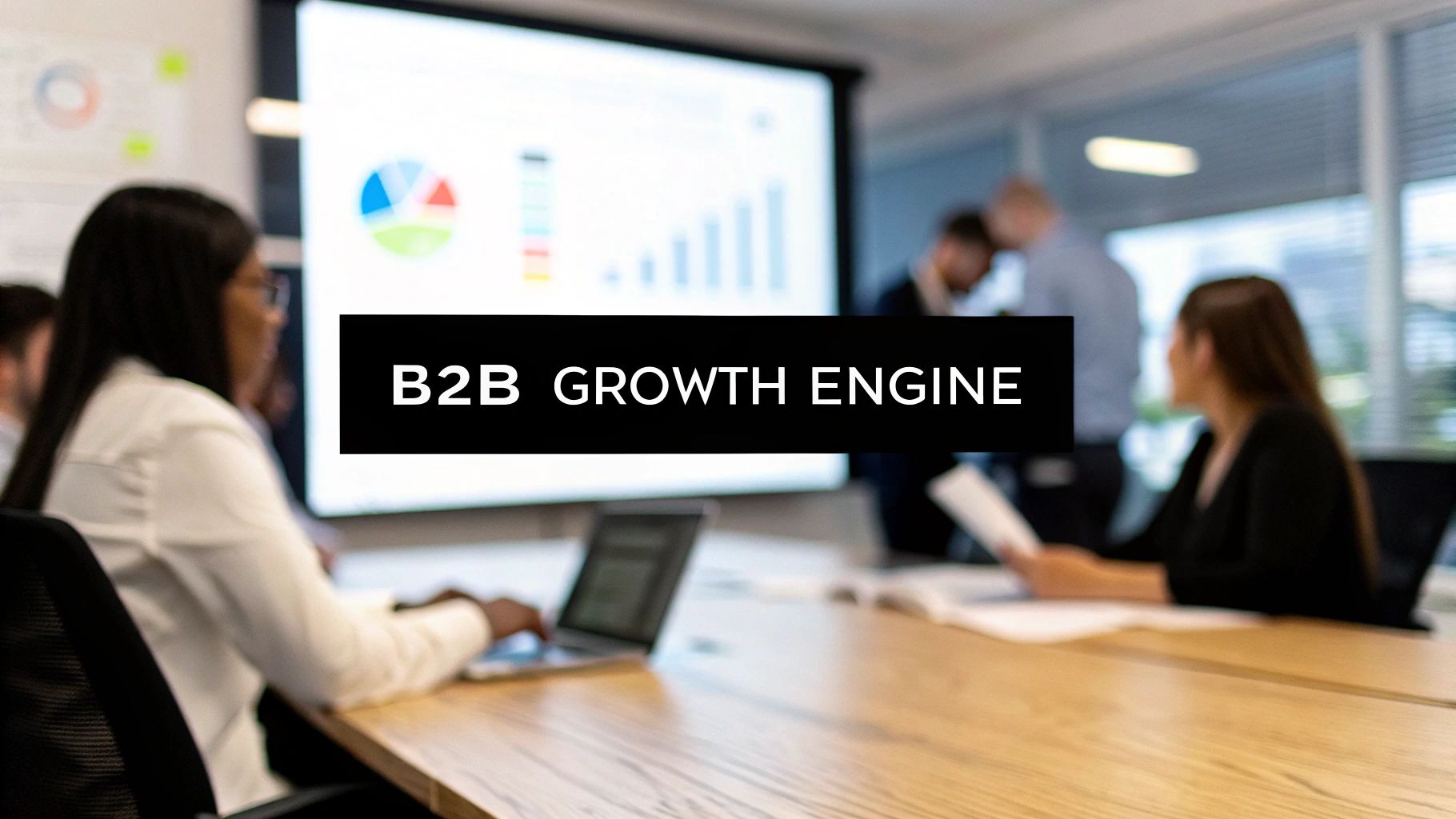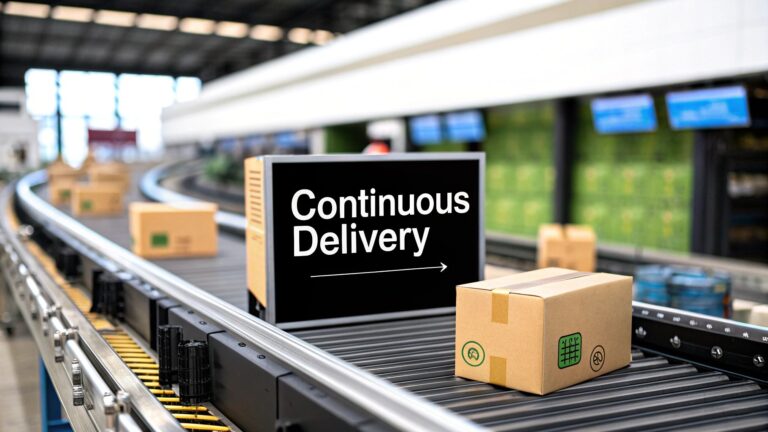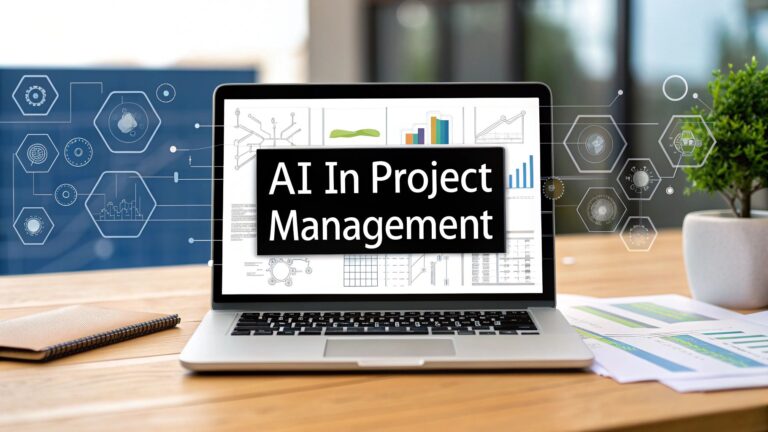10 Proven B2B Customer Acquisition Strategies for 2025
In today's competitive landscape, generic outreach and casting a wide net no longer cut it. B2B customer acquisition has evolved into a sophisticated discipline requiring a multi-faceted, strategic approach. High-value deals are won not by shouting the loudest, but by building trust, demonstrating expertise, and engaging prospects with precision. The old playbook of cold calls and email blasts is outdated; modern growth demands a more intelligent, targeted, and value-driven methodology.
This guide moves beyond the basics to provide ten battle-tested b2b customer acquisition strategies that deliver scalable, predictable revenue. Each strategy is a complete system for attracting, engaging, and converting your ideal clients. We will cover everything from high-touch Account-Based Marketing and authoritative Content Marketing to scalable LinkedIn outreach and high-converting webinar funnels. To further delve into building your core strategy, consider reviewing comprehensive B2B customer acquisition strategies.
We’ll dive into the specific tactics, tools, and automation opportunities that can transform your acquisition efforts from a costly guessing game into a streamlined growth engine. Forget surface-level advice; this is a roundup of actionable frameworks you can implement immediately. You will learn not just what to do, but how to execute each play effectively, measure its impact, and integrate it into a cohesive customer acquisition machine. Let's explore the proven methods that top-performing companies use to consistently win their most valuable customers.
1. Account-Based Marketing (ABM)
Account-Based Marketing (ABM) flips the traditional marketing funnel on its head. Instead of casting a wide net to capture as many leads as possible, ABM is a hyper-focused strategy that treats individual high-value accounts as markets of one. This approach tightly aligns sales and marketing teams to orchestrate personalized campaigns aimed at a curated list of target companies, making it one of the most effective B2B customer acquisition strategies for high-ticket sales.
The core principle is simple: focus your resources on the prospects most likely to convert into significant, long-term customers. Rather than a "spray and pray" methodology, ABM identifies key accounts first and then engages decision-makers within those organizations with highly relevant, coordinated messaging across multiple channels.
How to Implement ABM
A successful ABM campaign requires a methodical approach, moving from broad identification to personalized execution.
- Identify & Select High-Value Accounts: Start by building your Ideal Customer Profile (ICP). Use firmographic data (industry, company size, revenue) and technographic data (what technologies they use) to create a list of target accounts. Platforms like 6sense or Demandbase use intent data to identify companies actively researching solutions like yours.
- Map Key Stakeholders: Within each target account, identify the key decision-makers, influencers, and end-users. Create detailed buyer personas for roles like the CFO, Head of Operations, or IT Director to understand their specific pain points and motivations.
- Execute Personalized Campaigns: Develop bespoke content, ads, and outreach sequences for each account. This could involve personalized landing pages, direct mail with custom-branded items, targeted LinkedIn ads aimed at specific job titles within the company, and coordinated email outreach from both marketing and sales.
Key Insight: The goal of ABM is not just lead generation; it's about building deep relationships within target accounts. Success is measured by account penetration, engagement levels, and ultimately, closed-won deals, not just lead volume.
To master this strategy, you must first be an expert in segmentation. For a deeper dive, learn more about effective customer segmentation strategies on makeautomation.co. This foundational knowledge is crucial for identifying and prioritizing the right accounts for your ABM efforts.
2. Content Marketing & Thought Leadership
Content Marketing is a strategic approach focused on creating and distributing valuable, relevant, and consistent content to attract and retain a clearly defined audience. In the B2B space, this evolves into thought leadership, where the goal is not just to attract, but to establish your company as the foremost authority in its niche. By educating your audience and solving their problems before they ever become a customer, you build trust and brand preference, making this one of the most sustainable B2B customer acquisition strategies.
The principle is to pull customers in (inbound marketing) rather than pushing your message out. When a potential buyer searches for a solution to a problem, your insightful whitepaper, detailed blog post, or data-driven report should be the resource they find. This positions your brand as a helpful expert, not just a vendor, nurturing leads organically through the buyer's journey.

How to Implement Content Marketing & Thought Leadership
A successful content strategy requires a deep understanding of your audience's challenges and a commitment to providing genuine value.
- Address Buyer Pain Points: Base your content calendar on the actual questions and challenges your Ideal Customer Profile (ICP) faces. Use keyword research tools to find what they're searching for, but also interview sales teams and current customers to uncover nuanced pain points.
- Create Pillar and Cluster Content: Develop comprehensive, long-form "pillar" pages on broad topics central to your business. Then, create shorter "cluster" content (like blog posts or articles) that link back to the pillar page, covering specific subtopics in detail. This structure, famously championed by HubSpot, is excellent for SEO and establishing topical authority.
- Optimize and Repurpose: Optimize every piece of content for relevant search terms to capture organic traffic. Don't let your efforts stop with one format; repurpose a webinar into a blog post, a research report into an infographic, and key stats into social media snippets to maximize reach and appeal to different learning styles.
Key Insight: Thought leadership isn't about promoting your product; it's about providing an expert perspective on your industry. The goal is to become the go-to resource, so when the time comes to purchase, your brand is already the trusted choice.
To truly excel, your content must be powered by a robust understanding of search intent. For a comprehensive guide on this topic, explore how to master search intent for B2B success on makeautomation.co. This knowledge will ensure your content not only ranks but also resonates with the right audience at the right time.
3. LinkedIn Outreach & Social Selling
LinkedIn has evolved from a simple online resume repository into the world's most powerful B2B networking and prospecting platform. LinkedIn Outreach and Social Selling involve leveraging this network to directly connect with decision-makers, build authentic relationships, and guide them into your sales funnel. This strategy moves beyond cold calling, focusing instead on warming up leads through content engagement, personalized messaging, and establishing professional credibility.
For modern B2B customer acquisition strategies, LinkedIn is non-negotiable. It provides direct access to over 800 million professionals, allowing sales and marketing teams to identify, connect with, and nurture prospects with unparalleled precision. Platforms like Apollo.io and Outreach.io have built entire sales engagement ecosystems around LinkedIn, demonstrating its centrality to a scalable outreach plan.
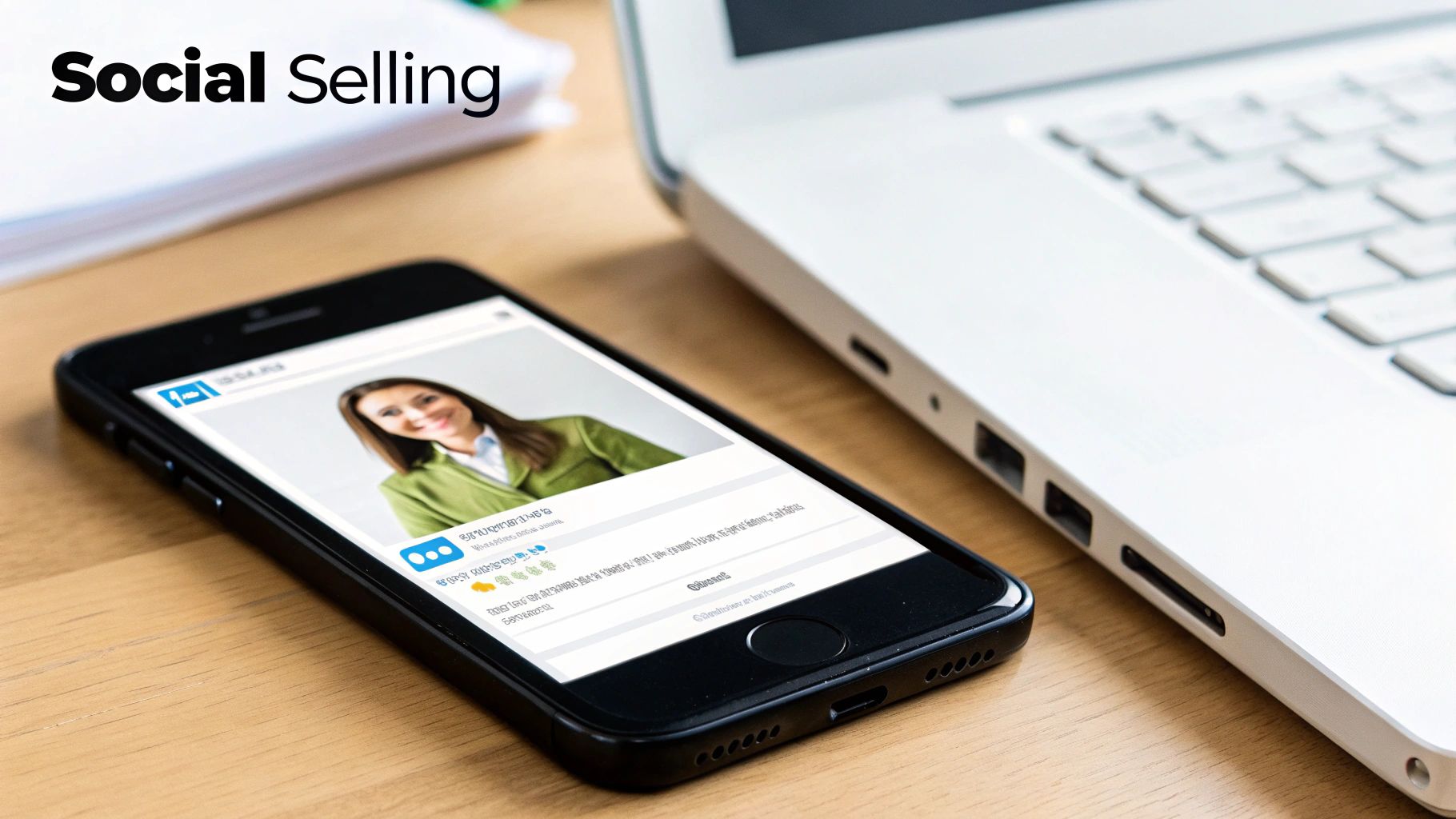
How to Implement LinkedIn Outreach
Effective social selling on LinkedIn is part art, part science. It requires a systematic approach that prioritizes genuine connection over aggressive selling.
- Optimize Your Profile: Your LinkedIn profile is your digital storefront. Ensure your headshot is professional, your headline clearly states the value you provide (e.g., "Helping SaaS companies reduce churn with AI analytics"), and your summary tells a compelling story.
- Identify and Engage Prospects: Use LinkedIn Sales Navigator for advanced search filters to build highly targeted prospect lists. Before sending a connection request, engage with their content by liking, commenting, or sharing their posts. This simple step significantly increases connection acceptance rates.
- Execute Personalized Outreach: Ditch the generic templates. Craft a personalized connection request mentioning a mutual connection, a recent post they shared, or their company's latest achievement. Your follow-up messages should offer value, such as a relevant article or a helpful insight, before ever asking for a meeting.
Key Insight: The primary goal of social selling is to build trust and establish yourself as a helpful resource, not to close a deal in the first message. The sale is a natural byproduct of a strong, value-driven relationship.
Mastering this strategy means shifting your mindset from "always be closing" to "always be helping." To further enhance your targeting, consider exploring advanced techniques. For a deeper understanding, learn more about leveraging LinkedIn Sales Navigator for B2B lead generation. This tool is fundamental for executing a sophisticated social selling strategy.
4. Email Marketing & Multichannel Outreach Sequences
Email marketing remains a cornerstone of B2B customer acquisition, but its power is magnified when integrated into a multichannel outreach sequence. This strategy involves orchestrating a series of timed, personalized touchpoints across different platforms like email, LinkedIn, and phone calls. Instead of sending one-off messages, you create a cohesive journey that builds familiarity and guides a prospect toward a conversation.
The approach moves beyond simple email blasts to a more intelligent, context-aware form of communication. By combining channels, you increase your chances of cutting through the noise and engaging a prospect where they are most active. This makes it one of the most scalable and effective B2B customer acquisition strategies for nurturing leads from awareness to decision.
How to Implement Multichannel Outreach
A successful sequence requires careful planning, personalization, and a commitment to providing value at every step.
- Design Your Sequence: Map out a sequence of 5-7 touchpoints spread over a few weeks. A common flow might start with a personalized LinkedIn connection request, followed by an email referencing their industry or a recent company achievement. Subsequent steps could include another value-driven email, a LinkedIn message, and finally, a cold call.
- Personalize at Scale: Use automation platforms like Outreach or Salesloft to manage the sequence, but inject genuine personalization. Reference specific content they've shared, mention a mutual connection, or comment on a recent company announcement. The goal is to show you've done your homework.
- Provide Value First: Each touchpoint should offer value before asking for anything. Share a relevant case study, an insightful article, or an invitation to a webinar. Position yourself as a helpful resource, not just a salesperson.
Key Insight: The effectiveness of a multichannel sequence lies in its persistence and relevance. Most B2B sales require multiple touchpoints; a structured sequence ensures you follow up consistently without being generic or overly aggressive, building rapport over time.
Mastering this strategy requires a solid foundation in email automation and personalization. To learn how to build the engine for your outreach, explore these automated email marketing campaigns on makeautomation.co. This knowledge is key to creating sequences that convert.
5. Webinars & Virtual Events
Hosting webinars and virtual events is a powerful B2B customer acquisition strategy that positions your company as a thought leader while generating high-quality leads. Instead of a hard sell, this approach focuses on delivering genuine value by educating your audience on topics relevant to their challenges. It provides a platform to showcase your expertise, build trust, and engage directly with potential customers in a scalable format.
The core principle is to attract a relevant audience by offering valuable, educational content for free. Companies like Gong and Marketo have built massive pipelines by consistently hosting webinars that solve real problems for their ideal customers. This method allows you to capture lead information, understand attendee interests, and nurture prospects through an interactive, live experience or on-demand recordings.
How to Implement Webinars & Virtual Events
A successful virtual event requires careful planning from topic selection to post-event follow-up, ensuring maximum engagement and conversion.
- Choose & Validate Your Topic: Select a topic that directly addresses a significant pain point for your Ideal Customer Profile (ICP). Validate interest by polling your email list or social media audience. The topic should be educational, not a product demo, establishing your brand as a helpful expert.
- Promote Extensively: Begin promotion 4-6 weeks in advance across multiple channels. Use email marketing, paid social ads targeting specific job titles, organic social media posts, and partner promotions to drive registrations. Highlight the speaker's credentials and the key takeaways attendees will gain.
- Execute & Engage: Plan your presentation to be between 45-60 minutes, leaving ample time for a live Q&A session to boost engagement. Use polls, chat, and interactive elements to keep the audience involved. Ensure you provide downloadable resources like slides, checklists, or whitepapers.
Key Insight: The value of a webinar extends far beyond the live event. Recording the session allows you to repurpose the content into blog posts, social media clips, and lead-nurturing email sequences, creating a long-lasting asset for your content marketing engine.
Webinars are a cornerstone of many successful B2B customer acquisition strategies because they build authority and a direct line of communication with prospects. Mastering this requires a commitment to consistently delivering high-value content that educates and empowers your audience.
6. Partner & Channel Programs
Partner and channel programs represent a powerful force multiplier in B2B customer acquisition strategies by allowing you to tap into established audiences and distribution networks. Instead of solely relying on your own marketing and sales efforts, this strategy involves building a collaborative ecosystem of complementary businesses, resellers, or technology partners who promote and sell your product or service to their own customer base.
The underlying principle is mutual benefit: your partners gain a new revenue stream or a value-added solution for their clients, while you gain access to a warm, pre-qualified market that would be costly and time-consuming to reach otherwise. From referral agreements to deeply integrated technology partnerships like the Salesforce AppExchange, this approach builds credibility and accelerates market penetration through trusted third-party endorsements.
How to Implement Partner & Channel Programs
Building a successful partner program requires a strategic framework focused on mutual growth and clear communication.
- Identify & Recruit Aligned Partners: Begin by defining your Ideal Partner Profile (IPP). Look for companies that serve a similar customer base but are not direct competitors. For example, a marketing automation platform might partner with CRM implementation agencies. Reach out with a clear value proposition outlining how the partnership will benefit their business and their customers.
- Provide Comprehensive Enablement: Your partners are an extension of your sales team, so equip them for success. Provide them with thorough product training, marketing collateral, sales scripts, and dedicated support channels. HubSpot’s certified agency partner program is a prime example, offering extensive resources and a tiered system that rewards growth.
- Establish a Clear Framework: Create a formal partner agreement that outlines commissions, referral processes, co-marketing commitments, and rules of engagement. Implement a Partner Relationship Management (PRM) system to track leads, manage payouts, and facilitate communication, ensuring transparency and efficiency.
Key Insight: A successful partner program is not a "set it and forget it" channel. It's a relationship that requires continuous investment in enablement, communication, and joint planning to ensure long-term, mutually beneficial growth.
Mastering this approach means treating your partners as true extensions of your team. For more on creating effective collaborations, explore how strategic partnerships can drive business growth on forbes.com. This will help you structure agreements that foster trust and shared success.
7. Paid Search & Google Ads Campaigns
Paid search, also known as Search Engine Marketing (SEM), is a foundational B2B customer acquisition strategy that places your brand directly in front of prospects who are actively searching for solutions. By bidding on specific keywords on platforms like Google Ads, you can capture high-intent traffic from decision-makers at the exact moment they are evaluating options, making it a powerful tool for driving qualified leads and sales.
Unlike strategies that build awareness over time, paid search delivers immediate visibility. For example, a SaaS company can bid on "best CRM for small business" to appear at the top of search results, instantly connecting with companies ready to buy. This direct-response mechanism offers a clear and measurable path from ad spend to revenue.
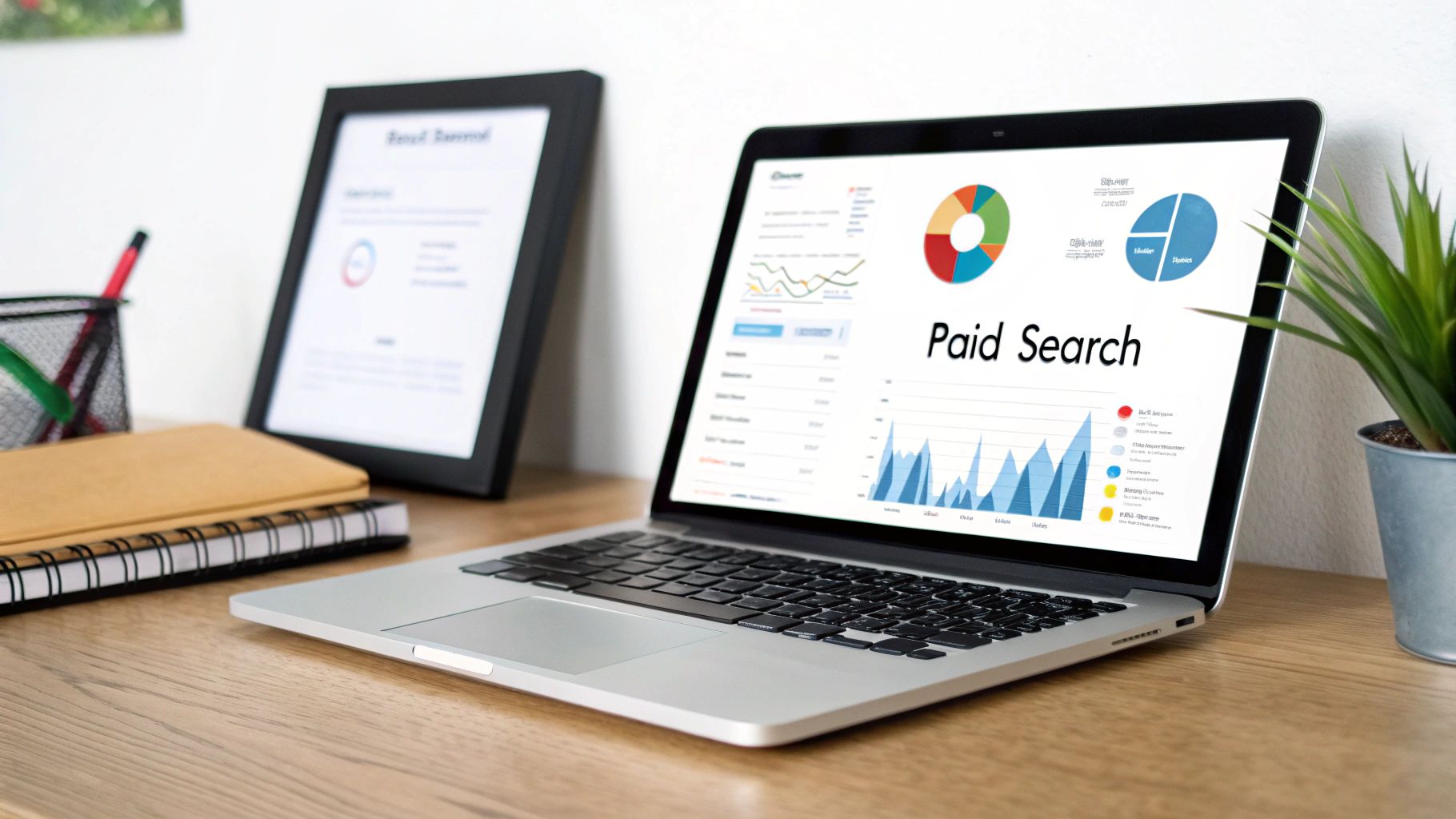
How to Implement Paid Search Campaigns
An effective paid search strategy requires precision, from keyword selection to post-click experience, ensuring every dollar spent maximizes return.
- Target High-Intent Keywords: Begin by focusing on long-tail keywords that signal strong purchase intent. Instead of a broad term like "recruiting," a technical recruiting firm should target "hire senior python developer services." These specific phrases attract prospects who are further along in the buying journey.
- Create Dedicated Landing Pages: Never send paid traffic to your homepage. For each ad group, create a dedicated landing page with messaging that directly mirrors the ad copy and keyword. If your ad promises a demo for "customer service software," the landing page should exclusively feature that offer.
- Implement Robust Tracking & Optimization: Accurately set up conversion tracking in Google Ads to measure leads, demo requests, or sales. Continuously use negative keywords to filter out irrelevant searches (e.g., "free," "jobs," "training") and A/B test ad copy variations to improve click-through rates and quality scores.
Key Insight: The success of a paid search campaign hinges on alignment. The keyword, ad copy, and landing page must all tell the same cohesive story, answering the searcher's query directly and guiding them seamlessly toward a single, clear call-to-action.
To get the most out of your budget, it's crucial to understand how to write compelling ad copy that grabs attention and drives action. For a masterclass in crafting effective ad copy, explore the foundational principles offered by WordStream's expert guides.
8. Referral & Affiliate Programs
Referral and affiliate programs leverage your most powerful marketing asset: your existing network of happy customers, partners, and industry influencers. This strategy incentivizes these advocates to refer new business through a structured system of rewards, commissions, or recognition. It transforms word-of-mouth from a passive occurrence into a predictable and scalable B2B customer acquisition channel.
The core principle is to build a flywheel of growth where new customers are brought in by existing ones, creating a cost-effective and self-sustaining acquisition loop. Unlike traditional advertising, referrals come with built-in trust and social proof, leading to higher conversion rates and lower customer acquisition costs. A well-executed program can tap into networks you could never reach on your own.
How to Implement Referral & Affiliate Programs
Building a successful program requires making participation simple, valuable, and easy to track for both you and your partners.
- Define Clear & Attractive Incentives: Design a commission or reward structure that is genuinely motivating. This could be a recurring percentage of the referred customer's subscription (common in SaaS), a flat-rate cash bonus for a closed deal, or service credits. The key is to make the reward compelling enough to encourage active promotion.
- Make Referring Effortless: The process must be frictionless. Provide each partner with a unique referral link and a dedicated portal or dashboard where they can access marketing materials (like logos, banners, and email templates), track their referrals, and monitor their commissions. Simplicity is crucial for adoption.
- Equip & Nurture Your Partners: Don't just launch the program and hope for the best. Actively manage your relationships with referrers and affiliates. Provide regular updates, share best practices, offer co-marketing opportunities, and celebrate their successes publicly to foster a strong and engaged community.
Key Insight: A successful referral program is built on a foundation of a great product and strong customer relationships. It's not a shortcut for a poor offering; it's an amplifier for a solution that already delivers significant value.
To create a program that truly scales, your operational processes must be seamless. For inspiration on building efficient systems, you can learn more about leveraging workflow automation at makeautomation.co. This knowledge can help you automate referral tracking, commission payouts, and partner communications.
9. Trade Shows, Events & In-Person Networking
In a world dominated by digital outreach, the power of face-to-face interaction remains one of the most impactful B2B customer acquisition strategies. Participating in industry conferences, trade shows, and targeted networking events allows you to build genuine relationships, generate high-quality leads, and establish a tangible brand presence that digital channels alone cannot replicate.
This strategy puts your team directly in front of a concentrated audience of potential buyers, partners, and industry influencers. Unlike cold outreach, event attendees are actively seeking solutions and are open to conversations, making it a prime environment for meaningful engagement. Events like Salesforce's Dreamforce or industry-specific summits like Web Summit create invaluable opportunities for direct connection and market validation.
How to Implement Trade Shows, Events & In-Person Networking
Maximizing your return on event investment requires a strategic plan that extends beyond just showing up and setting up a booth.
- Select the Right Events & Set Goals: Before committing, rigorously research events to ensure their attendee profile matches your Ideal Customer Profile (ICP). Set clear, measurable goals for each event, such as the number of qualified leads to capture, meetings to schedule, or partnerships to explore.
- Invest in Pre-Show Engagement: Your event strategy should begin weeks before the doors open. Use event attendee lists (if available) and platforms like LinkedIn to identify and schedule meetings with key prospects and target accounts beforehand. This guarantees you have dedicated time with high-value contacts.
- Optimize Booth Experience & Follow-Up: Design an engaging booth that clearly communicates your value proposition. Train your staff not just to pitch, but to ask qualifying questions and listen. Use badge scanning technology for efficient lead capture and, most importantly, execute a rapid follow-up sequence within 24-48 hours while the conversation is still fresh.
Key Insight: The true ROI of an event is realized in the follow-up. A meticulously organized post-show nurturing campaign is what turns a business card into a closed deal. Treat every lead captured as a warm introduction that requires immediate and personalized attention.
While technology facilitates lead capture, the core of this strategy is human connection. For a deeper understanding of building and leveraging professional relationships, explore the principles outlined in Dale Carnegie's "How to Win Friends and Influence People". The book's timeless advice is directly applicable to building rapport in a trade show environment.
10. Inbound Marketing & SEO-Driven Strategy
Inbound marketing is a comprehensive strategy focused on attracting customers through valuable content and tailored experiences. Instead of pushing interruptive outbound messages, this approach pulls prospects in by creating and distributing content that directly addresses their problems and questions. As one of the most scalable B2B customer acquisition strategies, it builds brand authority and generates a consistent stream of qualified leads over time.
The methodology, popularized by companies like HubSpot and Moz, revolves around creating helpful resources that align with each stage of the buyer's journey. By optimizing this content for search engines (SEO), you ensure that your ideal customers find you at the exact moment they are looking for a solution. This builds trust and positions your company as a go-to expert in your industry.
How to Implement an Inbound & SEO Strategy
A successful inbound engine is built on a foundation of strategic content creation and meticulous optimization.
- Map Content to the Buyer's Journey: Create different types of content for each stage: awareness (blog posts, infographics), consideration (webinars, case studies), and decision (free trials, demos). This ensures you have relevant assets to nurture leads from initial discovery to final purchase.
- Target High-Intent Keywords: Focus on long-tail keywords (e.g., "best CRM software for small construction firms") that indicate a user is closer to making a purchasing decision. Use tools like Ahrefs or Semrush to identify these opportunities and build content pillars around core topics.
- Optimize and Refresh Content: Don't just publish and forget. Regularly update your best-performing articles with new data and insights to maintain their search rankings. Optimize for on-page SEO elements like titles, meta descriptions, and internal linking to signal relevance to search engines.
Key Insight: Inbound marketing is a long-term asset. A single well-ranking blog post can generate leads for years, creating a powerful, compounding effect that lowers customer acquisition costs over time.
Mastering inbound requires a deep understanding of how to guide prospects through a structured journey. To build a system that converts visitors into customers, learn more about how to build effective sales funnels on makeautomation.co. This knowledge is essential for turning your content traffic into tangible business results.
B2B Customer Acquisition — 10-Strategy Comparison
| Strategy | Implementation complexity | Resource requirements | Expected outcomes | Ideal use cases | Key advantages |
|---|---|---|---|---|---|
| Account-Based Marketing (ABM) | High — intensive research and orchestration | High — sales+marketing alignment, personalized content, ABM tools | High ROI on target accounts, larger deal sizes, improved win rates | Enterprise B2B, high-value accounts, long sales cycles | Precise targeting, stronger account relationships, higher deal value |
| Content Marketing & Thought Leadership | Medium–High — strategy and steady production | Medium — content team, SEO, distribution channels | Long-term inbound leads, authority, compounding organic traffic | Brand building, complex buying cycles, inbound lead generation | Evergreen value, credibility, lower CAC over time |
| LinkedIn Outreach & Social Selling | Medium — profile optimization and personalized outreach | Low–Medium — time investment, tools (Sales Navigator) | Direct access to decision‑makers, relationship-based leads | B2B prospecting, SDR outreach, account development | Targeted outreach, relationship building, cost-effective contact |
| Email Marketing & Multichannel Sequences | Medium — sequence design, automation setup | Medium — ESP, lists, copywriting, integration | Measurable engagement and conversions, scalable nurture flows | Lead nurturing, onboarding, re‑engagement, trial conversion | Scalable, measurable, automatable touchpoints |
| Webinars & Virtual Events | Medium–High — production and promotion logistics | Medium — platform, speakers, marketing promotion | High-quality leads, strong engagement, recorded assets for reuse | Product demos, education, mid-to-late funnel nurturing | Live interaction, authority building, repurposable content |
| Partner & Channel Programs | High — partner selection and program management | Medium–High — enablement, co-marketing, partner ops | Expanded reach, shared revenue opportunities, new channels | Market expansion, complementary ecosystems, reseller models | Access to partner audiences, shared costs, credibility boost |
| Paid Search & Google Ads Campaigns | Medium — keyword strategy and landing optimization | Medium–High — ad spend, SEM expertise, analytics | Immediate visibility for high-intent queries, measurable ROI | Demand capture, product launches, time-sensitive offers | Fast results, precise intent targeting, scalable budget control |
| Referral & Affiliate Programs | Low–Medium — program setup and tracking | Low–Medium — commission payouts, platform, partner management | Lower CAC, higher-quality referred leads, gradual scale | Products with strong word-of-mouth, membership/consumer apps, B2B referrals | Cost-effective growth, trust-driven leads, scalable via advocates |
| Trade Shows, Events & In-Person Networking | High — logistics, booth design, staffing | High — travel, booth costs, sponsorship, staff time | High-quality leads, brand visibility, direct relationships | Industry expos, product launches, enterprise sales | Face-to-face engagement, networking, competitive intelligence |
| Inbound Marketing & SEO-Driven Strategy | Medium–High — content + technical SEO coordination | Medium — content creators, SEO tools, time investment | Sustainable organic growth, compounding traffic, qualified leads | Long-term growth, content-led acquisition, lower CAC goals | Durable search visibility, compounding ROI, qualified intent traffic |
Building Your Integrated Acquisition Engine
The journey through these ten powerful B2B customer acquisition strategies reveals a crucial truth: sustainable growth is not born from a single silver bullet. From the surgical precision of Account-Based Marketing to the broad, foundational strength of an SEO-driven inbound strategy, each approach offers a unique pathway to your ideal customer. We’ve explored how to build authority through Content Marketing, forge direct connections with LinkedIn Outreach, and scale engagement with sophisticated Email Marketing sequences. We've seen the power of community in Webinars and Partner Programs, the immediacy of Paid Search, and the timeless value of in-person Networking.
The ultimate goal, however, isn't to just master one of these in isolation. The most successful B2B companies weave these individual threads into a cohesive, interconnected system-a true customer acquisition engine.
From Silos to Synergy: Creating a Compounding Effect
Imagine the power of a system where each strategy amplifies the others. Your thought leadership content doesn't just sit on a blog; it becomes the cornerstone of your SEO efforts, drawing in organic traffic. That same content is then repurposed into compelling assets for your LinkedIn social selling campaigns and serves as the lead magnet for your Google Ads. The leads generated are then funneled into automated, multichannel outreach sequences, nurturing them toward a sales conversation or an invitation to your next webinar.
This synergy creates a powerful compounding effect. Your efforts in one area directly fuel the success of another, building momentum that is far greater than the sum of its parts. Instead of ten separate tactics, you have one integrated machine working tirelessly to attract, engage, and convert high-value clients. This is the modern blueprint for scalable B2B customer acquisition strategies.
Actionable Next Steps: Your Path Forward
Reading this list is the first step, but action is what drives results. Don't feel overwhelmed by the need to implement everything at once. The key is to be strategic and methodical.
- Audit and Assess: Begin by evaluating your current efforts. Which of these strategies are you already using? Where are your biggest gaps and opportunities? Use data, not assumptions, to identify what's working and what isn't.
- Prioritize and Focus: Select one or two strategies that align best with your Ideal Customer Profile (ICP), your team's strengths, and your immediate business goals. If you need high-value enterprise clients, an ABM pilot program might be the perfect start. If your goal is to build a long-term, sustainable lead source, doubling down on content and SEO is a wise investment.
- Automate to Accelerate: As you implement and connect these strategies, manual execution will quickly become your biggest bottleneck. Repetitive tasks like lead routing, data enrichment, personalized follow-ups, and performance reporting can consume valuable hours. This is where strategic automation becomes non-negotiable. By automating the operational workflows that underpin your acquisition engine, you free your team to focus on high-impact activities like building relationships and closing deals.
The path to mastering B2B customer acquisition is a marathon, not a sprint. It requires a commitment to testing, learning, and continuously optimizing your approach. By building an integrated, automated engine, you are not just chasing leads; you are creating a predictable and scalable system for growth that will serve as the foundation of your company's success for years to come.
Ready to move from manual tasks to a fully integrated and automated growth engine? At MakeAutomation, we specialize in designing the end-to-end automated workflows that connect your marketing, sales, and operations, turning these B2B customer acquisition strategies into a seamless, scalable system. Visit MakeAutomation to see how we can help you build the powerful, efficient engine your business deserves.

